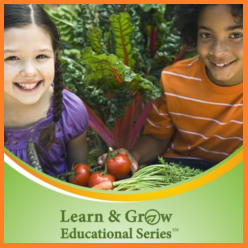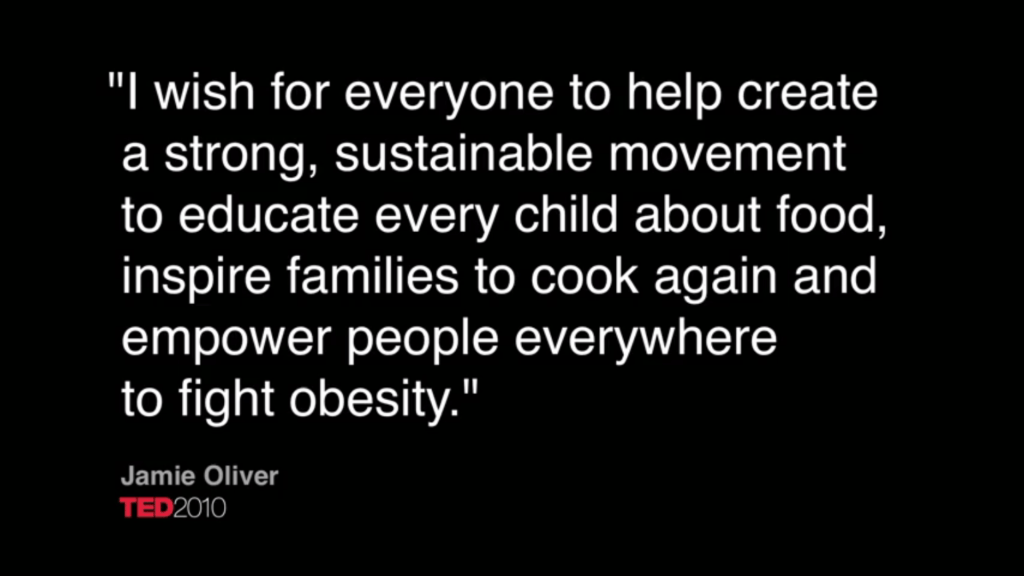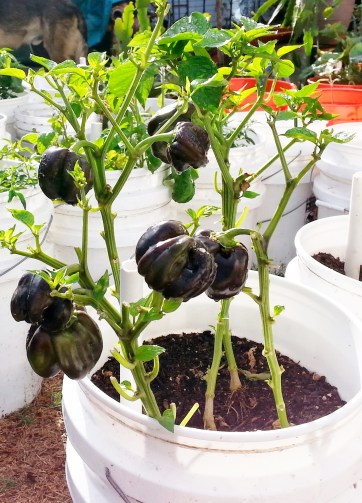 Eventually, after months of tending your garden, you and your learner will be ready to harvest your produce. It will be tempting to pick baby vegetables like green beans, squash, and carrots before they are done growing.
Eventually, after months of tending your garden, you and your learner will be ready to harvest your produce. It will be tempting to pick baby vegetables like green beans, squash, and carrots before they are done growing.
Eating baby vegetables is perfectly healthy and delicious! Just leave enough fruit and vegetables growing in your garden to reach maturity or your learner will never get the benefit of seeing the whole plan play itself out.
Some produce, like tomatoes, will not taste good if picked and eaten early. Unless you are growing green-when-ripe tomatoes or peppers, you will know they are ready to pick when they change color.
Peas and beans are ready to pick when they have stopped getting longer and have formed the bumps of seeds inside. The pods of some varieties, such as purple hull peas and borlotti beans, will change color or develop colorful streaks once ready to pick.
Some peas and beans should be shelled. Shelling removes the seeds from inside the pea or bean pods, then only the seeds are eaten. Others can be eaten pod and all.
Root vegetables, such as beets and carrots are judged by feeling their tops through the soil to see how big around they are. This, of course, does not tell you how long they are, so learning to judge when carrots and beets are really ready to pull takes some practice.
Researching the growing behaviors of the different plants you are raising with your concrete learner helps foster the notion that reading is not just for entertainment, but also for information. Placing a value on information and knowledge is one of the key concepts underlying the Common Core.
You want to foster your learner’s critical thinking and problem-solving abilities by giving him/her challenges to solve that are at his/her developmental level. Problem-solving skills, like everything else, are enhanced through repeated use. 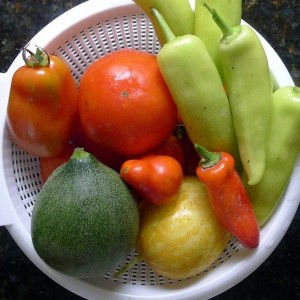
You will need a container for your produce when you harvest from your self-watering container garden. A bowl or colander is usually sufficient. If you have a highly productive garden, you may need a small milk crate, basket, or tub.
Collect your fresh produce in your container and, if possible, gently rinse it off with a hose (over your compost, if you have a compost pile or bin). This will get most of the dirt off before you take the produce into your kitchen.
Once in your kitchen, you can wash your produce more carefully with a vegetable wash to make sure that all treatments for insects and diseases, dust and dirt, bug and bird poop, and anything else that may have gotten on your food is washed off. (Vegetables grown commercially usually undergo this same initial cleaning process before they are brought to market, but you still are advised to wash purchased fresh produce before you eat it.)
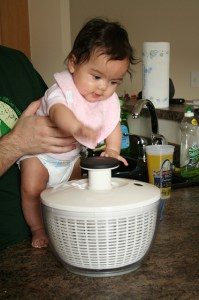 If you and your learner have picked greens like lettuce, spinach, beet leaves, kale, etc., it is very helpful to also have a salad spinner, which will spin the excess water off the leaves and help prevent them from rotting in the refrigerator before you’ve had a chance to eat them. Concrete learners usually really enjoy operating salad spinners (of course, they are pretty fun – as pictured, here, even sensorimotor children with emerging preoperational skills want to get in on the salad spinner action).
If you and your learner have picked greens like lettuce, spinach, beet leaves, kale, etc., it is very helpful to also have a salad spinner, which will spin the excess water off the leaves and help prevent them from rotting in the refrigerator before you’ve had a chance to eat them. Concrete learners usually really enjoy operating salad spinners (of course, they are pretty fun – as pictured, here, even sensorimotor children with emerging preoperational skills want to get in on the salad spinner action).
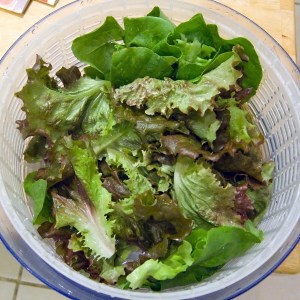
With your learner, wash and rinse your produce well. Even if you have been diligent in your use of only organic, safe products in your garden, you probably don’t want the tastes of the things you’ve sprayed and sprinkled all over your plants in your dinner.
It is important to teach your learner about handling food safely. It’s not enough to use safe fertilizers and insect repellents to keep your fruits and vegetables healthy; they also have to be clean when eaten. One never knows what airborne pathogen might fly in on the breeze one day and land on one’s tomatoes.
Concrete learners learn well from rehearsed procedures that each achieve observable purposes. They like to make things happen. The sense that a person can make something happen by acting upon the environment is called agency.
Concrete learners have already come to understand from their preoperational days that they are agents capable of acting upon the environment in order to make things happen. The concepts of “I,” “me,” and “mine” are achieved during the preoperational stage. The awareness that other people also have agency occurs during the concrete operational stage, at which point they can conceptualize an understanding of “we” and work as part of a team.
Giving concrete learners positive, constructive activities, such as raising and cooking their own fruits and vegetables, gives them an outlet for their emerging senses of agency that is also a powerful teaching vehicle for many other lessons. Our Learn & Grow Educational Series is devoted to the first aspect of food knowledge: what food is and where it comes from. Other resources exist to educate children about how to prepare healthy meals.
A very valuable resource to increase your learner’s knowledge of food, making healthy food choices, and learning how to prepare healthy meals is Jaime Oliver’s Food Revolution, which emphasizes the importance of teaching children about these very things. Knowledge powers solutions for parents, as we like to say here at KPS4Parents, and educating parents on how to teach food knowledge and skills to their children is an important part of the Food Revolution.
Child and family nutrition is at the heart of the Food Revolution. There are community-based resources throughout the United States that you can look up on the Food Revolution website.
Mr. Oliver won a TED Prize for his work in the United States with his Food Revolution. You can see the video of his intelligent, fact-based, yet touching TED speech by clicking here.
